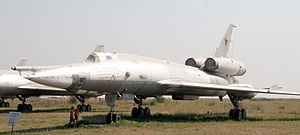Tupolev Design Bureau
Tupolev Tu-22 Blinder
 |
|
| Tu-22PD | |
| Role | Medium bomber |
|---|---|
| National origin | Soviet Union |
| Manufacturer | Tupolev |
| First flight | 7 September 1959 |
| Introduction | 1962 |
| Retired | Early 2000s (Libya) |
| Status | Retired |
| Primary users | Soviet Air Force Ukrainian Air Force Libyan Air Force Iraqi Air Force |
| Produced | 1960–1969 |
| Number built | 311 |
|
|
.
History Public Joint Stock Company Tupolev,
Tupolev Tu-22 Blinder Nickname "All"

The Tupolev Tu-22 (Air Standardization Coordinating Committee name: Blinder) was the first supersonic bomber to enter production in the Soviet Union. Manufactured by Tupolev, the Tu-22 entered service with Long-Range Aviation and Soviet Naval Aviation in the 1960s.
The aircraft was a disappointment, lacking both the speed and range that had been expected. It was also a difficult design to fly and maintain. It was produced in small numbers, especially compared to the Tupolev Tu-16 it was designed to replace. The aircraft was later adapted for other roles, notably as the Tu-22R reconnaissance aircraft and as a carrier for the long-range Kh-22 antiship missile.
Tu-22s were sold to other nations, including Libya and Iraq. The Tu-22 was one of the few Soviet jet bombers to see combat: Libyan Tu-22s were used against Tanzania and Chad, and Iraqi Tu-22s were used during the Iran–Iraq War.

Into service

The Tu-22 entered service in 1962, but it experienced a considerable number of problems, resulting in widespread unserviceability and several crashes. Amongst its many faults was a tendency for aerodynamic heating of the aircraft skin at supersonic speed, distorting the control rods and causing poor handling. The landing speed was 100 km/h (62 mph) greater than of the previous bombers and the Tu-22 had a tendency to pitch up and strike its tail on landing – though this problem was eventually resolved with the addition of electronic stabilization aids. Even after some of its problems had been resolved, the Blinder was not easy to fly, and was maintenance-intensive. Among its unpleasant characteristics was a wing design that allowed aileron reversal at high speeds. When the stick had been neutralized following such an event, the deformation of the wing did not necessarily disappear, but could persist and result in an almost uncontrollable aircraft.
0
KmCeiling
0
KmCombat RANGE
0
MachAircraft Speed
0
Max Crew
Photo Gallery
Public Joint Stock Company Tupolev,
Tupolev Tu-22 Blinder Nickname "All"


Public Joint Stock Company Tupolev,
Tupolev Tu-22 Blinder
General Info
-
-
-
- Crew: 3 (pilot, navigator, weapons officer)
- Length: 41.6 m (136 ft 6 in)
- Wingspan: 23.17 m (76 ft 0 in)
- Height: 10.13 m (33 ft 3 in)
- Wing area: 162 m2 (1,740 sq ft)
-
-
-
Powerplant
-
-
-
- Gross weight: 85,000 kg
- Max takeoff weight: 92,000 kg
- Powerplant: 2 × Dobrynin RD-7M-2 afterburning turbojet engines, 107.9 kN (24,300 lbf) thrust each dry, 161.9 kN (36,400 lbf) with afterburner
-
-
-
.
Links to Youtube & Others
The only Soviet combat use of the Tu-22 occurred in 1988, during the Soviet withdrawal from the war in Afghanistan. Tu-22P Blinder-E electronic jammers were given the task of covering the withdrawal route back to the Soviet Union.
Tupolev Design Bureau Tupolev Tu-22 Blinder
Iraq used its Tu-22s in the Iran–Iraq War from 1980 to 1988
Youtube Link
The last flight of a Libyan Blinder was recorded on 7 September 1992. They are probably now unserviceable because of a lack of spare parts,












